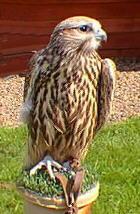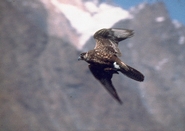

Common Names: Saker
Falcon, Altai Saker, Steppe Saker
Genus: Falco
Species: cherrug

The saker falcon is a big, strong bird of prey with large feet and pointed wings. It is larger than the peregrine falcon, and has a very wide wingspan for its size. There are several subspecies of saker falcons; the steppe Saker (Falco cherrug cherrug), the mountain Saker (Falco cherrug milvipes), and the Altai Saker (Falco cherrug altaicus ). The saker falcon has a large range of color, from dark brown to grey, to almost white. Saker falcons are also thought to breed with gyrfalcons and form a hybrid falcon.
The saker falcon originated in southeast Europe and Asia. Their preferred habitats are the open plains and forest steppes. They can be found on the steppes of Mongolia and of southern Siberia, and the Russian Altai mountains.
The saker falcon is about 18 inches tall. They have large eyes and a short, hooked beak. Steppe saker falcons use the nests of Black Kites (Milvus migrans) and Imperial Eagles (Aquila heliaca). The mountain saker build its nest on cliffs. Saker falcons lay 2 to 5 eggs. In the winter they migrate south to Kazakhstan and the Middle East.
They spent most of their time hunting for mammals like voles, rats, stoats, weasels, northern pikas, Siberian chipmunks, and birds. They dive for their prey at 200 mph. The saker falcon are ferocious hunters and often attacks prey that is bigger than itself. Female saker falcons are more ferocious than the males and are preferred by falconers. In the wild they have no natural enemies, except man.

The larger, dark brown and gray barred Altai Saker falcons are the favorite bird of Arab falconers. Many of the birds are trapped in Arab countries when they are on their migration to the Middle East. In the past it was the custom to capture juvenile female sakers and train them to hunt because they were easier to train than adult birds.
Because the birds have become scarce, both adult and juvenile birds are now being caught throughout Asia and sold to the Middle Eastern falcon market. Without breeding adults in the wild, the saker falcon's population is in danger of declining.
There are no accurate figures for the population of Saker falcons, but it is believed that there are only 1,000 pairs of birds left in Russia, and 130 pairs in the rest of Europe. Some scientists think the decline of the steppe Saker is caused by the regional extinction of their preferred prey, the Red-cheeked Sousliks (Citellus erythrogenys), which is a type of ground squirrel. Global temperature changes has brought about changes in the vegetation on which the sousliks survived. Because the climate changed, the plants which Sousliks ate died, which caused the Sousliks to die off in that region, which is causing the Steppe Saker falcon population to decline. There are only about 200 pairs of Steppe Saker falcons left and they may become extinct in the next 10 to 15 years.
2000
Bibliography:
"Mongolian Steppe", http://www.fonz.org/zoogoer/zgl1997/mongolian.htm, (June '00).
"Saker Falcon", http://www.discoverit.co.uk/falconry/saker/htm, (June '00)
"Research", http://www.gyrfalcon.co.uk/FFI_research.htm, (Aug '02)
Eastham, Chris, "saker falcon paper", http://www.gyrfalcon.co.uk/Saker%20falcon%20- %20its%20use%20in%20arabic%20falconry%20and%20conservation.htm, (Aug '02).
Eastham, Chris, "saker falcon paper 2", http://www.gyrfalcon.co.uk/What%20is%20an%20altai%20falcon.htm,(Aug '02).
"Altay Saker", http://www.falcons.co.uk/MEFRG/Falco/16/Altay.htm